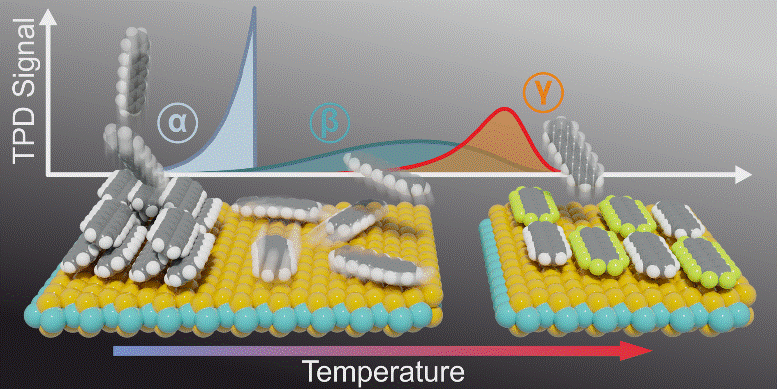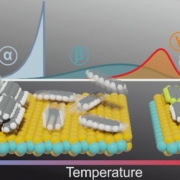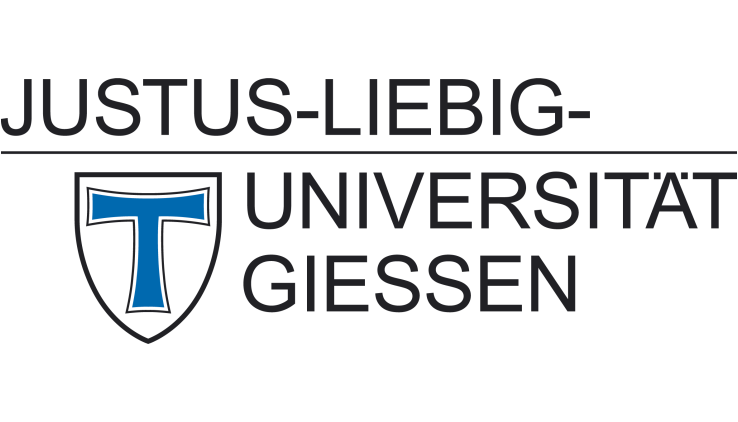Engineering of TMDC-OSC Hybrid Interfaces: The Thermodynamics of Unitary and Mixed Acene Monolayers on MoS2 – Publication by A2 (Witte) and A4 (Gottfried)
In a new publication in Chemical Science, projects A2 (Witte) and A4 (Gottfried) report on the intricate desorption characteristics of pentacene (PEN) and perfluoropentacene (PFP) monolayers on the MoS2 surface. Unitary molecular monolayers are thermally stabilized by entropy due to their high mobility rather than the organic/inorganic interface bond, which hampers the formation of close-packed and well-ordered monolayers.

Schematic representation of characteristic TPD traces and the temperature-dependent molecular diffusivity of unitary PEN films (left hand side) and the stabilized mixed PEN:PFP monolayer (right hand side) on MoS2 (Image: P. Dombrowski). Copyright by CC-BY-NC 3.0.
Van der Waals (vdW) bound hybrid heterosystems of inorganic two-dimensional materials (2DMs) and OSCs are currently receiving great attention due to their promising characteristics for the fabrication of flexible electronics and ultra-thin devices. While prototypical devices with 2DM-OSC hybrid heterostructures have been realized, the fundamental understanding of the 2DM-OSC interface is lacking. In their new study, the authors were able to thoroughly unravel the interplay of interface and intermolecular interactions and their effect on the structure and thermal stability of molecular monolayers.
Through temperature-programmed desorption (TPD) experiments, it was shown that the first molecular layers of PEN and PFP on MoS2 are thermally more stable than subsequent molecular layers in spite of an interface bond that is weaker than the molecular interlayer bond. This is possible due to an entropic stabilization that can only occur if the molecular adlayer is highly mobile. Thus, if the first molecular layer is only stabilized by its mobility, it cannot be well-ordered and close-packed even at low temperatures as low as 100 K. The high molecular diffusivity in the gas-like unitary PEN and PFP monolayers was identified by Monte-Carlo simulations: Intermolecular repulsion of intrinsic molecular electrostatic quadrupole moments, in combination with a weak substrate interaction, prohibits the formation of a condensed molecular monolayer.
By introducing attractive intermolecular interactions, condensation of the molecular films is favored. This was achieved in mixed monolayers of PEN and PFP that adopt a well-ordered stoichiometric 1:1 intermixture. In spite of a reduced mobility, the mixed monolayer is thermally stabilized with respect to the bulk substance due to the attractive intermolecular forces and can therefore be fabricated by selective multilayer desorption. This provides a promising prospect for the fabrication and subsequent study of well-defined 2DM-OSC interfaces for future studies within SFB 1083.
Publication
S.R. Kachel, P.-M. Dombrowski T. Breuer, J.M. Gottfried, G. Witte
Engineering of TMDC–OSC hybrid interfaces: the thermodynamics of unitary and mixed acene monolayers on MoS2
Chem Sci. (2021) DOI:10.1039/D0SC05633B
Contact
Prof. Dr. Gregor Witte
Philipps-Universität Marburg
SFB 1083, project A2
Tel.: +49 6421 28-21 384
EMAIL







